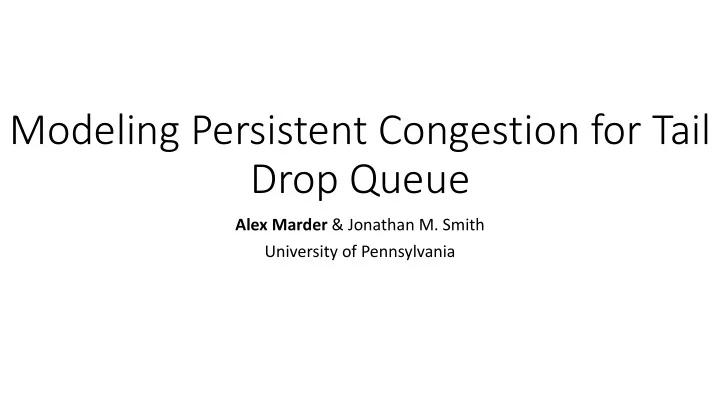

Modeling Persistent Congestion for Tail Drop Queue Alex Marder & Jonathan M. Smith University of Pennsylvania
Problem • Can we determine the severity of persistent congestion? • 100mbit >> 1mbit • Why? • How bad is interdomain congestion? • Is service degraded due to DDoS attack? • What about TCP?
Can We Use TCP? • Requires host on both sides of the link • Measures end-to-end throughput • Can be difficult to determine the bottleneck • Smaller RTT gets more throughput
Goals • Use edge probing to determine the average per flow throughput of TCP flows on persistently congested links
Controlled Experiments: Setup
Controlled Experiments • Use TCP flows to adjust per-flow throughput • 100 flows ≈ 10mbit, 1000 flows ≈ 1mbit • Flows last [1, 5] seconds • Immediately replaced by new flow • 1000 probes per measurement • 100ms intervals
FIFO Tail Drop Queue • Queue depth: maximum number of packets in queue • If Arrival Rate > Link Bandwidth • Queue size increases • If Arrival Rate < Link Bandwidth • Queue size decreases • Packets are dropped when queue is full
TCP Variants NewReno CUBIC • Additive Increase, Multiplicative • Slow Start, Fast Retransmit, Fast Decrease Recovery • Slow Start • Congestion Window increases follow a cubic function – quickly initially, but • Fast Retransmit slows as it nears old window size • Fast Recovery with partial ACKs • Partially decouples window increases from RTT • Default in current versions of Linux, MacOS, and Windows
Initial Setup
es and Spread TCP CUBIC: Mean Probe RTT Inc Increa eases creases as Per Flow Throughput De De Decr Decr creases
100mbit (10 Flows) – 1m 1mbit (1000 Flows) TCP CUBIC: 100m
10mbit (100 Flows) – 1m 1mbit (1000 Flows) TCP CUBIC: 10m
CUBIC vs NewReno: Mean and Spread are Different
CUBIC vs NewReno: Model for CUBIC is Unusable for NewReno
CUBIC vs NewReno: 1000 Probe RTTs Every 100ms
CUBIC vs NewReno: 1000 Probe RTTs Every 100ms
CUBIC vs NewReno: Probe RTTs Increase Slower Than Decrease
Percent Increasing Metric • Percentage of Probe RTTs where RTT i > RTT i-1 • Attempt to capture rate of queue increases vs decreases • Example: • 10 RTTs = [44, 46 , 48 , 43, 45 , 44, 47 , 42, 45 , 48 ] • 6 RTTs are greater than previous RTT • Percent Increasing = 60%
CUBIC vs NewReno: Percent Increasing Metric Reduces Potential Estimation Error (≈ 2Mbit)
CUBIC & NewReno Mixes: All Fall Between CUBIC and NewReno Curves
Bandwidth: Reduce Bandwidth to 500Mbit
Bandwidth: Measuring Raw Average Throughput
Measurements Are Independent of the Number of TCP Flows
Queue Depth: Increase By 4ms (From 48ms to 52ms)
Queue Depth: Stdev and % Increasing Are Resilient to Small Differences, Mean is Not
TCP RTT: Impact of Different RTTs
TCP RTT: Percent Increasing Estimation Error Based on RTT Assumption
TCP RTT: Probe RTTs Measure Throughput of Smallest TCP RTT Flows
Probing Through Congestion
1 st Link: Reverse Path Congestion
2 nd Link: Forward Path Congestion
Probing Through Congestion
Probing Through Congestion: Looks Possible
Conclusions & Future Work • Where it works: • Hopefully soon: • CUBIC, NewReno, mixed • Reduce error due to TCP RTT • Bandwidth • Probing through congestion • Queue depth • Assumed TCP RTT • New experiments: distribution • BBR • Higher bandwidths (10+ Gbit) • Throughput fluctuations
Recommend
More recommend